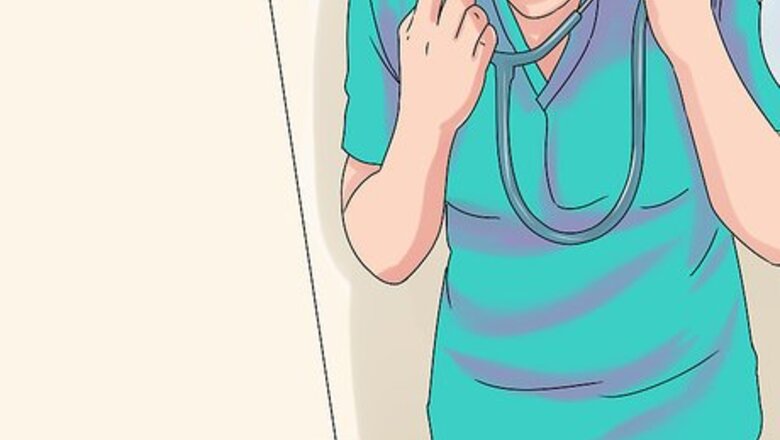
views
X
Research source
Some lumps can make guinea pigs very sick and uncomfortable if left untreated. If you see a lump on your guinea pig, take your guinea pig to your vet for diagnosis and treatment. The sooner your vet can treat your guinea pig, the sooner it can become healthy again.
Treating the Lump
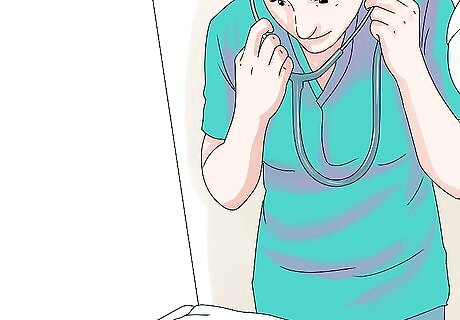
Seek veterinary treatment. Lumps on guinea pigs often require veterinary treatment. Frequently, treatment involves surgical removal of the lump. If the lump is infected, your guinea pig would need antibiotics to prevent the spread of infection after surgery. Do not try to treat a lump on your own.
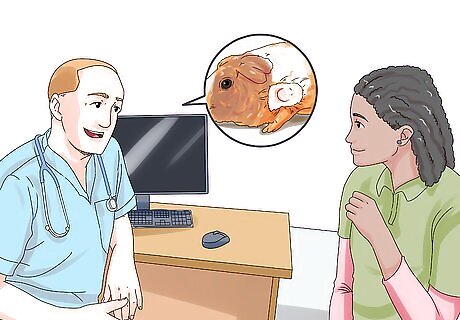
Discuss treatment challenges. Removing a guinea pig’s lump can be challenging. If the lump is infected, surgically removing it could release bacteria into the bloodstream, causing a serious condition called septicemia. Also, the pus within a guinea pig abscess has a thick, cheese-like consistency, making the typical abscess treatment—lancing and draining—ineffective in many cases. Lancing an abscess involves cutting it open with a sharp instrument. Sometimes, abscesses can form finger-like extensions and extend into nearby tissues, making complete removal difficult. Mouth abscesses are very challenging to treat because of their location. They can swell and block the throat. Also, if the abscess breaks open, the pus could fatally choke a guinea pig. Removing a cyst may be challenging as well, since the fluid inside of it may contain bacteria.

Allow your vet to surgically remove the lump. If your guinea pig can undergo surgery, your vet will anesthetize your guinea pig and remove the lump. In most cases, a guinea pig can go home on the same day of surgery. However, if your guinea pig has a mouth abscess, your vet may want to hospitalize your guinea pig because of the potential for serious health problems. For an abscess, a complete removal is very important. If the removal is incomplete, the abscess could come back. Surgical removal of a skin tumor is often curative, meaning that no other treatment is needed to treat the tumor. However, a more aggressive tumor may require additional treatment after removal.
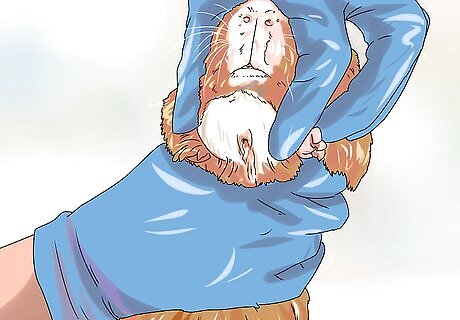
Have your vet lance and drain the abscess. Lancing may be a good option for mouth or jaw abscesses. After anesthetizing your guinea pig, your vet would first cut open the abscess and drain the fluid with a surgical drain. Next, they would flush the empty abscess with an antiseptic solution. Then, your vet may pack the empty abscess with antibiotic beads. Be aware that this treatment option makes it more likely for an abscess to come back. Flushing the abscess means to fill it with a liquid solution (the antiseptic), then suction the liquid back out. Your vet may have to flush the abscess several times to make sure all of the pus is out. The antibiotic beads would be effective for 2‒6 months.
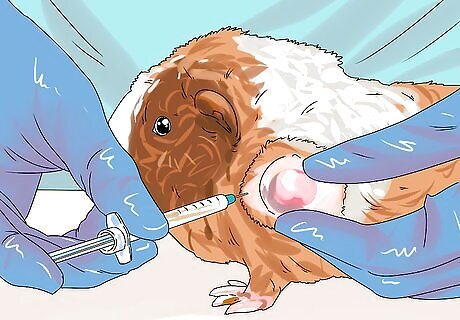
Allow your vet to inject the abscess with antibiotics. Not all abscesses require surgical removal. If your guinea pig’s abscess is less than 1 cm in diameter, your vet could inject antibiotics directly into the abscess. Your vet would inject the antibiotic into the abscess’s wall. Alternatively, your vet may want to flush the abscess periodically, rather than removing it. Flushing the abscess periodically will help prevent the abscess from causing problems. Your vet will let you know how often the abscess should be flushed.
Caring for Your Guinea Pig After Surgery

Place your guinea pig in a quiet environment. When you bring your guinea pig home after surgery, let it recover in a calm, quiet area. Place your guinea pig’s cage in an area that does not get a lot of foot traffic from you or other members of your household. If you have other guinea pigs, keep them in a separate cage from the sick guinea pig.
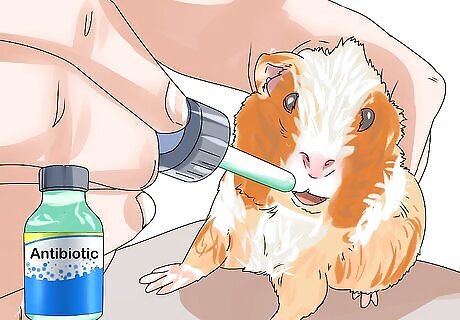
Give your guinea pig antibiotics. If the surgically-removed lump was an abscess or infected cyst, your guinea pig will need antibiotics to prevent post-surgical infection. Because certain antibiotics can make guinea pigs extremely sick, your vet will prescribe a guinea pig-safe antibiotic. Do not purchase antibiotics at a pet store; they may not be safe for your guinea pig. Guinea pigs typically need at least one round of antibiotics following surgical removal of an abscess. Your vet will determine how long your guinea pig will need antibiotic treatment. To give the antibiotic pill, hold your guinea pig, open its mouth, and put the pill as far back in the mouth as you can. If you can place the pill near the molars, your guinea pig will not be able to spit it back out easily. Give the full course of antibiotics. Do not stop the antibiotic treatment when your guinea pig starts looking and feeling better. This could lead to the growth of antibiotic-resistant bacteria.
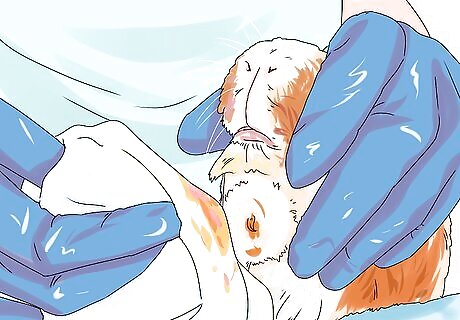
Clean the affected area. After surgery, keep the incision site clean and free of dirt and debris. To clean the incision site, use a clean, slightly damp towel and gently dab around the incision. That area may be a little painful for your guinea pig, so you do not want to use too much pressure. Examine the incision site for signs of infection: redness, swelling, discharge. If the incision site looks abnormal, take your guinea pig to your vet for treatment.

Schedule a follow-up appointment. Your vet may want to see your guinea pig again after surgery to monitor its recovery. During this follow-up appointment, your vet will examine the incision area, remove sutures (if necessary), and generally assess how your guinea pig is doing.
Preventing Future Lumps
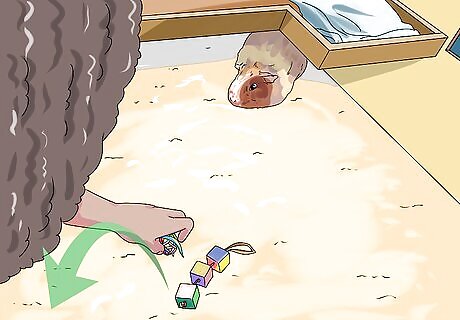
Remove sharp objects from the cage. You will not be able to prevent tumors, but you can prevent abscesses and cysts. Because abscesses and cysts form after a puncture wound, remove anything sharp or rough from your guinea pig’s cage. For example, straw bedding can pierce a guinea pig’s skin. Instead of straw bedding, use paper bedding like CareFresh® or Yesterday’s News cat litter. If any of your guinea pig’s toys have sharp edges, take those out as well. Ideal toys for a guinea pig cage are empty toilet paper or paper towel rolls since they are soft and smooth. Make sure your guinea pig’s food does not have any sharp edges that could damage his gums.

Separate fighting cage mates. If you house several guinea pigs together, separate them if they fight or bully each other. When they bite each other, that bite wound can become infected and form an abscess or cyst.

Correct dental problems. Malocclusion (improper teeth alignment) is a common dental problem in guinea pigs. If the teeth do not line up properly, they can overgrow and puncture the inside of the mouth. This puncture wound can lead to abscess or cyst. If your guinea pig’s teeth are misaligned, take your guinea pig to your vet for treatment. Correcting dental problems in guinea pigs requires surgery. Your vet will use specialized dental instruments to trim and realign the teeth.












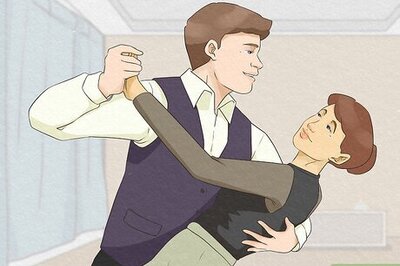

Comments
0 comment